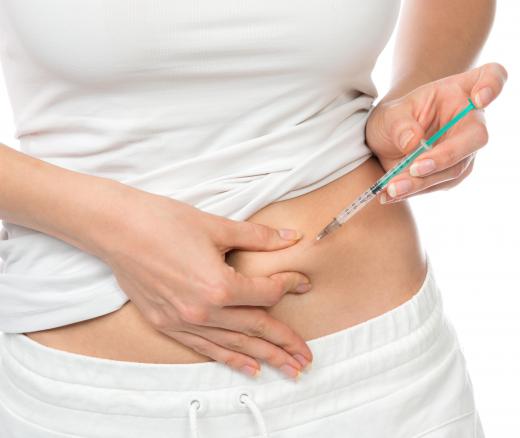What is Glucose Concentration?
Glucose concentration is a measurement of the quantity of glucose molecules that are present in a liquid solution. Where a glucose solution consists of pure water into which glucose has been dissolved, glucose concentration is often expressed as a percentage. In medicine, the concentrations of glucose in the blood, or in urine, are important indicators of health. In these fluids, glucose measurement is usually expressed in millimoles per liter (mmol/l).
In medicine, glucose concentration in the blood is more often referred to as the blood sugar level. In a healthy adult, the blood sugar level is usually expected to range from 3.6 mmol/l to 5.8 mmol/l. The glucose concentration in blood does tend to rise after a meal has been ingested, however. Typically, blood glucose concentration is at its lowest first thing in the morning, when a person gets up, and has not yet eaten breakfast.

A glucose test to determine the blood sugar level of a patient is usually performed by means of a strip of testing paper or plastic onto which a small drop of blood is placed. The test strip contains special chemicals that interact with the glucose in the blood. The test paper is then placed inside a specially configured meter, which provides a readout showing the glucose concentration of the blood.

Glucose monitoring is very important for patients with diabetes. In these individuals, the blood sugar level cannot be regulated properly. Blood sugar levels of diabetics rises to dangerous levels, resulting in a variety of symptoms, which can be very serious in extreme cases of the disease. Diabetics can control their blood sugar level with the help of drugs, along with careful management of their diet.

There are many forms of diabetes, all of which have as their main symptom an elevated level of glucose in the blood. The three most common types are type 1 diabetes, type 2 diabetes, and gestational diabetes. Individuals with type 1 diabetes have an impaired ability to produce insulin, the hormone that controls blood glucose concentration levels. Type 2 diabetes is characterized by normal levels of insulin, but a failure in the system of cells that normally respond to the insulin and act to reduce blood sugar. Gestational diabetes is a form of diabetes that occurs in pregnant women, and is often transient, with blood glucose concentration regulation returning to normal after the birth of the baby.
AS FEATURED ON:
AS FEATURED ON:















Discussion Comments
@anon348070: No, that's not normal. Your blood glucose should be under 7.7 or so, two hours after a meal, and a fasting blood sugar should be 5.5 or less.
You may be hypoglycemic, which means you tend to run low blood glucose levels. Oddly enough, the diet is the same as a diabetic: avoid sugars and high carb foods. Eat lean meats, lots of vegetables and so forth. Also, see your doctor for a complete blood workup. He or she can help you with your blood glucose dropping low.
I'm not diabetic. However, recently I am have been having episodes of severe shaking and headache within two or three hours of eating breakfast. When this happened the last time I tested, my blood glucose was 3.6mmol/l. is this normal?
@feruze-- mg/dl is milligrams per decilitre.
mmol/l has been the standard for measuring glucose concentration in serum. But some countries have started using mg/dl instead. In the US also, mg/dl is becoming more common. Some glucose testers measure in mmol/l and some measure in mg/dl. There are also some testers which allow you to switch between the two if you need to.
The difference is that they are different forms of measurements. mmol/l is a molecular measurement, mg/dl is a weight measurement. It doesn't matter which is used as long as the diabetic knows what the measurement means.
The only issue is if the person needs to convert between the two measurements to calculate glucose concentration. But you can do that fairly easily. All you need to do to convert mmol/l to mg/dl is to multiply the glucose concentration by eighteen. If you want to convert the other way around, from mg/dl to mmol/l, just divide by eighteen.
@burcidi-- What is mg/dl?
I thought serum glucose concentration readings always used mmol/l, millimoles per liter. Do some glucose testers use a different measurement?
What's the difference with mg/dl and mmol/l then? It doesn't matter which one is used as long as the person knows the reference values to compare their results right?
I have type two diabetes which I was diagnosed with several months ago. The thing with this type of diabetes is that it doesn't often show up in regular blood glucose readings. So when I check my fasting glucose levels and after-meal glucose levels two hours after eating, the amount of glucose in my blood appears normal. But when my glucose levels are checked after a high "sugar" meal and one hour after eating, my levels are extremely high.
That's why I had to get a special three hour glucose tolerance test at the hospital. They first took my blood in the morning when I was hungry. Then I was given a glucose concentration to drink which was just water with 75 grams of pure glucose mixed in. One hour and two hours later, I had blood drawn again to check blood glucose levels.
My one hour after level came out way too high, it was 240 mg/dl! It's not supposed to be over 140 mg/dl!
Post your comments